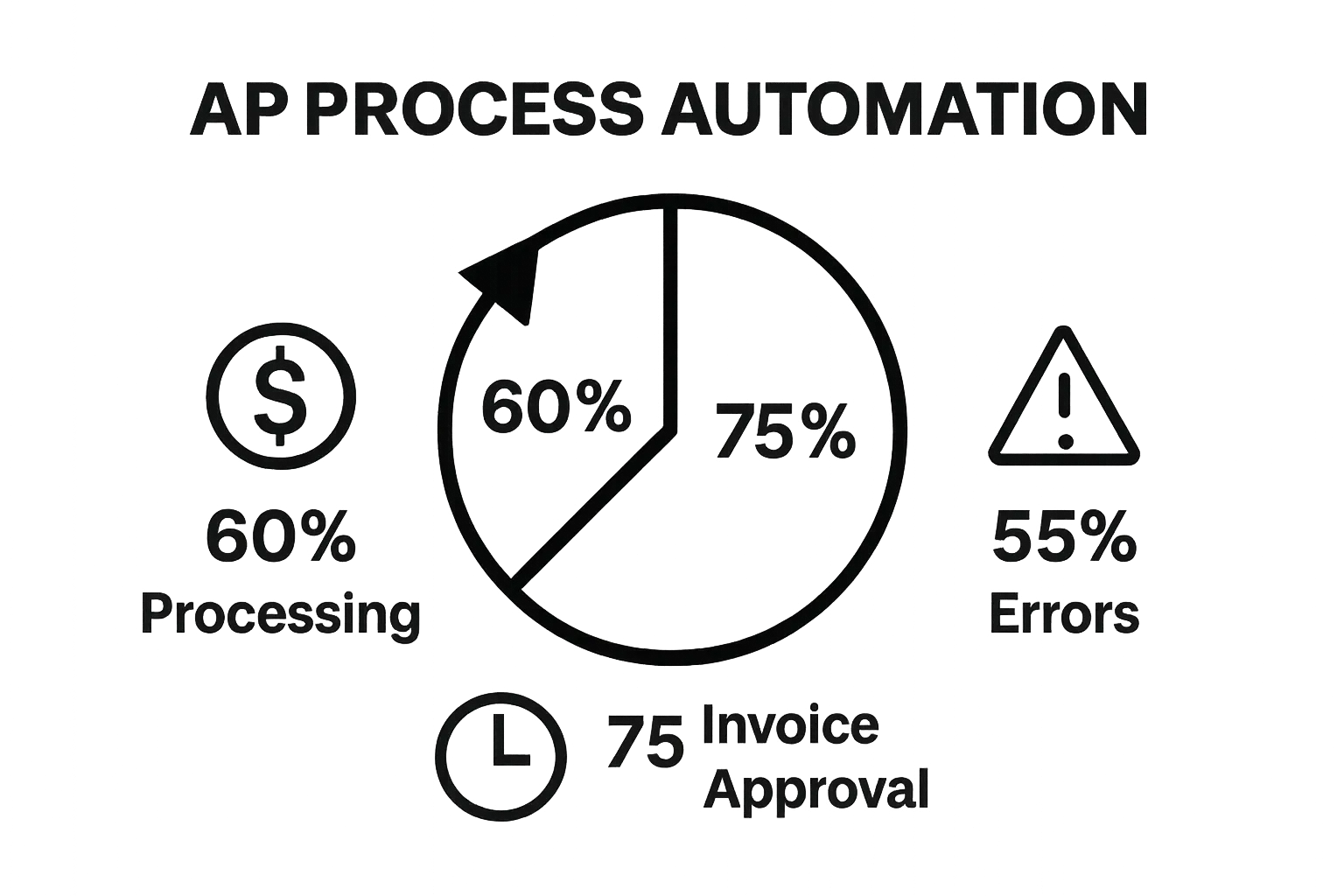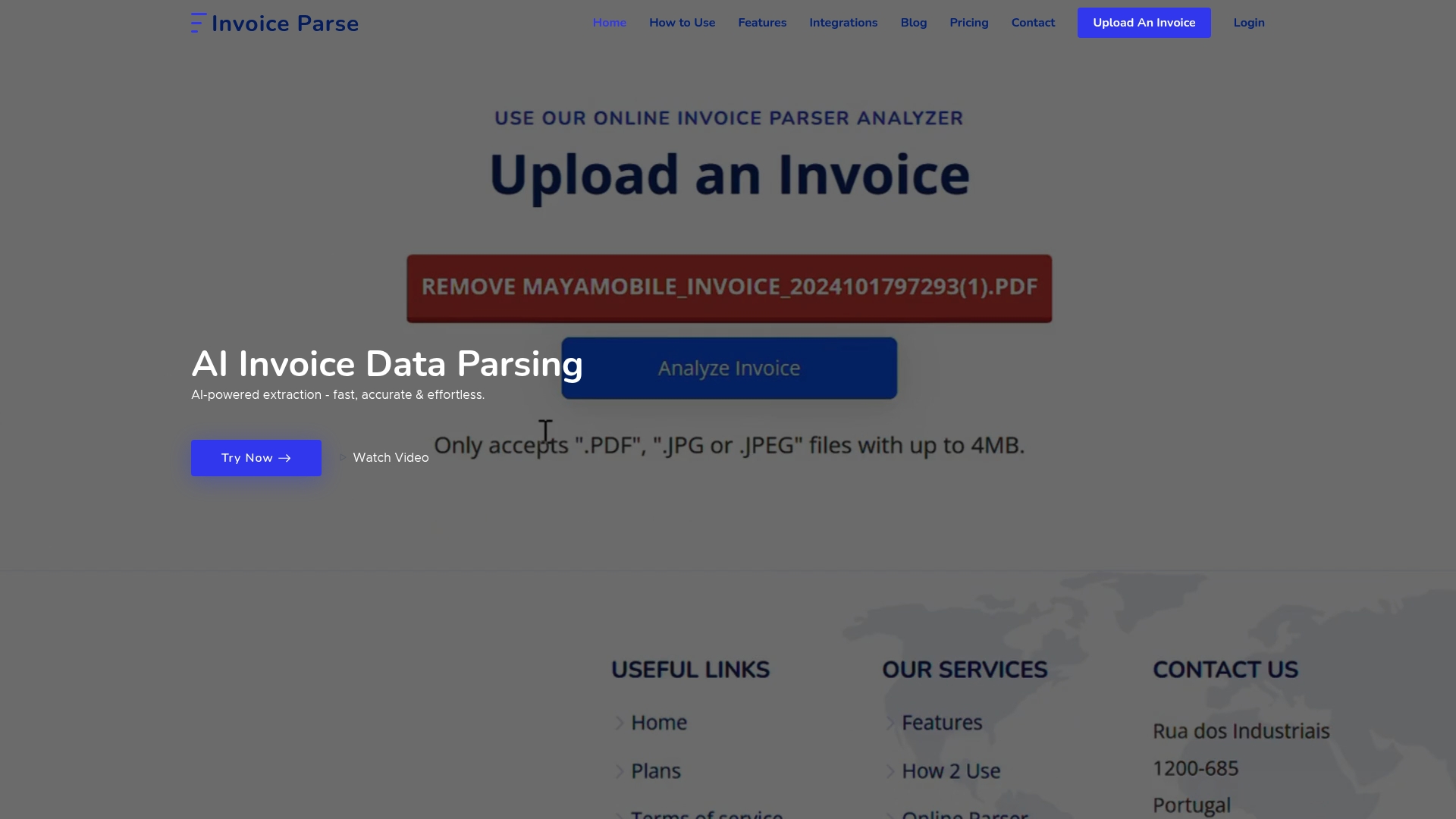AP process automation is changing how companies handle mountains of invoices and payments. Think manual sorting and data entry still rule finance teams? Actually, businesses using automation can cut processing costs by up to 80 percent. The real surprise is that the biggest winners are not just accounting departments but the entire company as teams shift from tedious paperwork to powerful decision making.

Understanding AP Process Automation for Businesses
Table of Contents
- What Is Ap Process Automation And Its Importance?
- Why Should Businesses Adopt Ap Process Automation?
- How Ap Process Automation Works: Key Components
- The Benefits Of Implementing Ap Process Automation
- Challenges And Considerations In Ap Process Automation
Quick Summary
| Takeaway | Explanation |
|---|---|
| AP automation reduces costs significantly. | Businesses can lower processing costs by up to 80% by adopting automation in their accounts payable functions. |
| Enhances operational efficiency. | Automated systems expedite invoice processing from days to just minutes, thereby streamlining workflows. |
| Improves compliance and reduces risk. | AP automation enhances compliance with financial regulations and minimizes the risk of errors and fraud. |
| Shifts focus to strategic tasks. | By automating repetitive tasks, finance teams can concentrate on higher-value strategic analysis and decision-making. |
| Enables real-time financial visibility. | Automation provides businesses with immediate insights into financial transactions, improving planning and responsiveness. |
What is AP Process Automation and Its Importance?
Accounts Payable (AP) process automation represents a transformative approach to managing financial transactions, utilizing advanced technological solutions to streamline invoice processing, payment workflows, and financial record management. Research from Deloitte Insights reveals that businesses adopting AP automation can significantly enhance operational efficiency and reduce manual administrative burdens.
Understanding AP Process Automation
AP process automation is a strategic technological intervention that replaces traditional manual invoice processing with intelligent, software-driven workflows. At its core, this approach leverages artificial intelligence, machine learning, and sophisticated algorithms to capture, validate, and process financial documents with unprecedented speed and accuracy.
Key components of AP process automation include:
- Document Capture: Automatically extracting data from invoices using advanced optical character recognition (OCR) technology
- Workflow Management: Routing invoices through predefined approval channels without manual intervention
- Data Validation: Cross-checking invoice details against existing purchase orders and vendor records
Business Impact and Strategic Benefits
By implementing AP process automation, organizations can unlock substantial operational advantages. The system eliminates human error, reduces processing time, and provides real-time visibility into financial transactions. Discover more about AP automation benefits to understand how this technology transforms financial operations.
Businesses leveraging AP automation typically experience:
- Reduced processing costs by up to 80%
- Faster invoice approval cycles
- Enhanced compliance and reduced risk of financial discrepancies
- Improved vendor relationship management through timely and accurate payments
The strategic importance of AP process automation extends beyond mere efficiency. It enables finance teams to transition from repetitive data entry tasks to more strategic financial analysis and decision making, positioning technology as a critical enabler of organizational growth and financial intelligence.
To help you quickly understand the different components that make up AP process automation, the table below summarizes each key feature and its primary function.
| Component | Description |
|---|---|
| Document Capture | Uses OCR to automatically extract data from invoices, reducing manual entry. |
| Workflow Management | Routes invoices through predefined approval channels, minimizing delays and bottlenecks. |
| Data Validation | Cross-checks invoice details with purchase orders and vendor records for accuracy. |
| Intelligent Data Extraction | Utilizes AI and machine learning to process structured and unstructured invoice formats. |
| Audit Trail & Compliance | Maintains a record of activities for transparency and regulatory adherence. |
| ERP Integration | Links with existing enterprise systems to enable seamless data transfer. |
| Exception Handling | Manages errors or discrepancies with automatic escalation for prompt resolution. |

Why Should Businesses Adopt AP Process Automation?
Businesses today face increasing pressure to optimize financial processes and reduce operational complexities. Research from MIT Sloan Management Review demonstrates that strategic technology adoption can dramatically transform organizational efficiency, particularly in accounts payable management.
Financial and Operational Efficiency
AP process automation delivers substantial benefits that extend far beyond simple digital transformation. By replacing manual, time consuming financial workflows with intelligent technological solutions, organizations can achieve unprecedented levels of operational performance.
Key financial efficiency gains include:
- Reducing invoice processing time from days to minutes
- Minimizing human error and potential financial discrepancies
- Enabling real-time financial visibility and reporting
- Freeing up accounting staff for strategic financial analysis
Competitive Advantage and Risk Mitigation
Companies implementing AP automation position themselves strategically in an increasingly digital business landscape. Learn more about AP automation challenges to understand the comprehensive impact of this technological transformation.
Risk mitigation benefits encompass:
- Enhanced compliance with financial regulations
- Improved audit trail and document tracking
- Reduced potential for fraudulent transactions
- Standardized and transparent financial processes
By embracing AP process automation, businesses transform accounts payable from a traditional administrative function into a strategic asset that drives organizational growth, financial intelligence, and competitive differentiation. The technology empowers finance teams to move beyond repetitive tasks and focus on high-value strategic initiatives that directly contribute to business success.
How AP Process Automation Works: Key Components
AP process automation transforms complex financial workflows through advanced technological integration. Research from Gartner indicates that intelligent automation technologies are revolutionizing how businesses manage financial processes with unprecedented precision and efficiency.
Document Ingestion and Data Extraction
The automation journey begins with sophisticated document capture technologies. Modern AP automation systems utilize advanced optical character recognition (OCR) and machine learning algorithms to seamlessly transform physical and digital invoices into structured, actionable data.
Key document processing capabilities include:
-
Extracting text and numerical data from multiple invoice formats
-
Automatically identifying and categorizing financial information
-
Handling unstructured and variable document layouts
-
Performing real-time data validation and error checking
Intelligent Workflow Management
Once data is extracted, AP automation platforms leverage intelligent routing mechanisms to streamline approval processes. Read more about business process automation trends to understand the broader technological landscape driving these innovations.
Workflow automation features encompass:
- Predefined approval hierarchies and routing rules
- Automatic escalation for exceptions and delays
- Integration with existing enterprise resource planning (ERP) systems
- Comprehensive audit trails and compliance tracking
By combining advanced data extraction with intelligent workflow management, AP process automation creates a holistic solution that transcends traditional manual processing. The technology enables businesses to transform accounts payable from a transactional function into a strategic asset, driving operational efficiency, reducing errors, and providing real-time financial insights.
The Benefits of Implementing AP Process Automation
Financial technologies are transforming how businesses manage critical accounting operations. Research from PwC highlights that strategic automation can deliver substantial competitive advantages across financial management processes.
Financial Performance and Cost Optimization
AP process automation drives significant financial improvements by eliminating inefficient manual workflows. Organizations can dramatically reduce operational expenses and redirect valuable human resources toward strategic financial planning and analysis.
Key financial performance benefits include:

- Reducing invoice processing costs by up to 80%
- Accelerating payment cycle times
- Minimizing late payment penalties
- Generating accurate financial forecasting through real-time data insights
Operational Efficiency and Risk Management
Beyond financial gains, AP automation provides comprehensive operational improvements. Explore our detailed guide on AP reconciliation processes to understand the nuanced advantages of automated financial systems.
Operational efficiency advantages encompass:
- Enhanced accuracy in financial record keeping
- Improved compliance with regulatory requirements
- Reduced human error and potential fraud risks
- Streamlined vendor management and communication
By implementing AP process automation, businesses transform their accounts payable from a traditional administrative function into a strategic asset. The technology empowers finance teams to transcend routine data entry, providing unprecedented visibility, control, and strategic insights that directly contribute to organizational growth and financial intelligence.
Challenges and Considerations in AP Process Automation
Implementing advanced technological solutions requires strategic planning and comprehensive understanding. Research from Harvard Business Review indicates that successful digital transformation demands careful evaluation of potential obstacles and proactive mitigation strategies.
Technical Integration and System Compatibility
One of the primary challenges organizations encounter when adopting AP process automation involves seamlessly integrating new technologies with existing financial infrastructure. Businesses must carefully assess their current systems, ensuring compatibility and minimal disruption during technological transitions.
Key technical integration considerations include:
- Evaluating existing enterprise resource planning (ERP) system capabilities
- Identifying potential data migration complexities
- Assessing software interoperability requirements
- Understanding potential legacy system limitations
Change Management and Employee Adaptation
Technological transformation extends beyond technical implementation and requires comprehensive organizational readiness. Learn more about understanding AP automation challenges to gain deeper insights into navigating organizational transitions.
Critical human factors to address include:
- Providing comprehensive training programs
- Managing employee anxiety about technological changes
- Demonstrating clear value propositions for automation
- Creating transparent communication channels
Successful AP process automation requires a holistic approach that balances technological innovation with strategic human capital management. By anticipating potential challenges and developing robust implementation strategies, businesses can effectively leverage automation technologies to drive operational excellence and financial performance.
The table below offers a side-by-side comparison of major benefits and key challenges associated with AP process automation to help you weigh the advantages against potential obstacles.
| Area | Major Benefits | Key Challenges |
|---|---|---|
| Cost | Reduces processing costs by up to 80% | Investment in new technology |
| Efficiency | Speeds up invoice approval and payment cycles | Technical integration complexities |
| Accuracy | Minimizes human error and enhances data validation | Data migration and compatibility issues |
| Compliance | Improves regulatory compliance and audit readiness | Managing change and employee adaptation |
| Strategic Value | Frees up teams for higher-value analysis and decision-making | Need for employee training and buy-in |
| Vendor Relations | Enables timely, accurate payments and better relationships | Ongoing system maintenance requirements |
Unlock True AP Process Efficiency with Invoice Parse
Are manual invoice workflows slowing your business down? If you are struggling with slow data entry, human error, or scattered financial records as discussed in “Understanding AP Process Automation for Businesses,” you are not alone. The time you spend hunting for invoice details and double-checking entries is valuable. Invoice Parse delivers instant, accurate extraction of invoice data so you can move past outdated manual processes. Our AI-powered platform recognizes and transforms invoice PDFs and images into structured data, giving you immediate clarity and control. No templates to build. No tedious setup required. Just drag, drop, and get realtime financial insight.

Ready to eliminate bottlenecks and drive operational savings? Discover how Invoice Parse can help you automate every step, from document ingestion to seamless integration with your reporting tools. Create a free account at Invoice Parse today or visit our homepage to see how easy true AP process automation can be. Take control of your financial operations now before another invoice pile lands on your desk.
Frequently Asked Questions
What is AP process automation?
AP process automation refers to a technology-driven approach that streamlines the management of accounts payable by automating invoice processing, payment workflows, and financial record management, thereby improving efficiency and reducing manual efforts.
How does AP process automation improve financial efficiency?
By automating manual tasks, AP process automation can reduce invoice processing time from days to minutes, minimize human error, and enable real-time visibility of financial transactions, which collectively enhance financial efficiency.
What are the main benefits of implementing AP automation in a business?
Implementing AP automation can lead to reduced processing costs, faster approval cycles, better compliance, improved vendor relationships, and allows finance teams to focus on strategic financial analysis instead of repetitive tasks.
What challenges might businesses face when adopting AP process automation?
Businesses may encounter challenges such as technical integration with existing systems, data migration complexities, change management issues, and the need for comprehensive employee training to adapt to the new automated processes.
